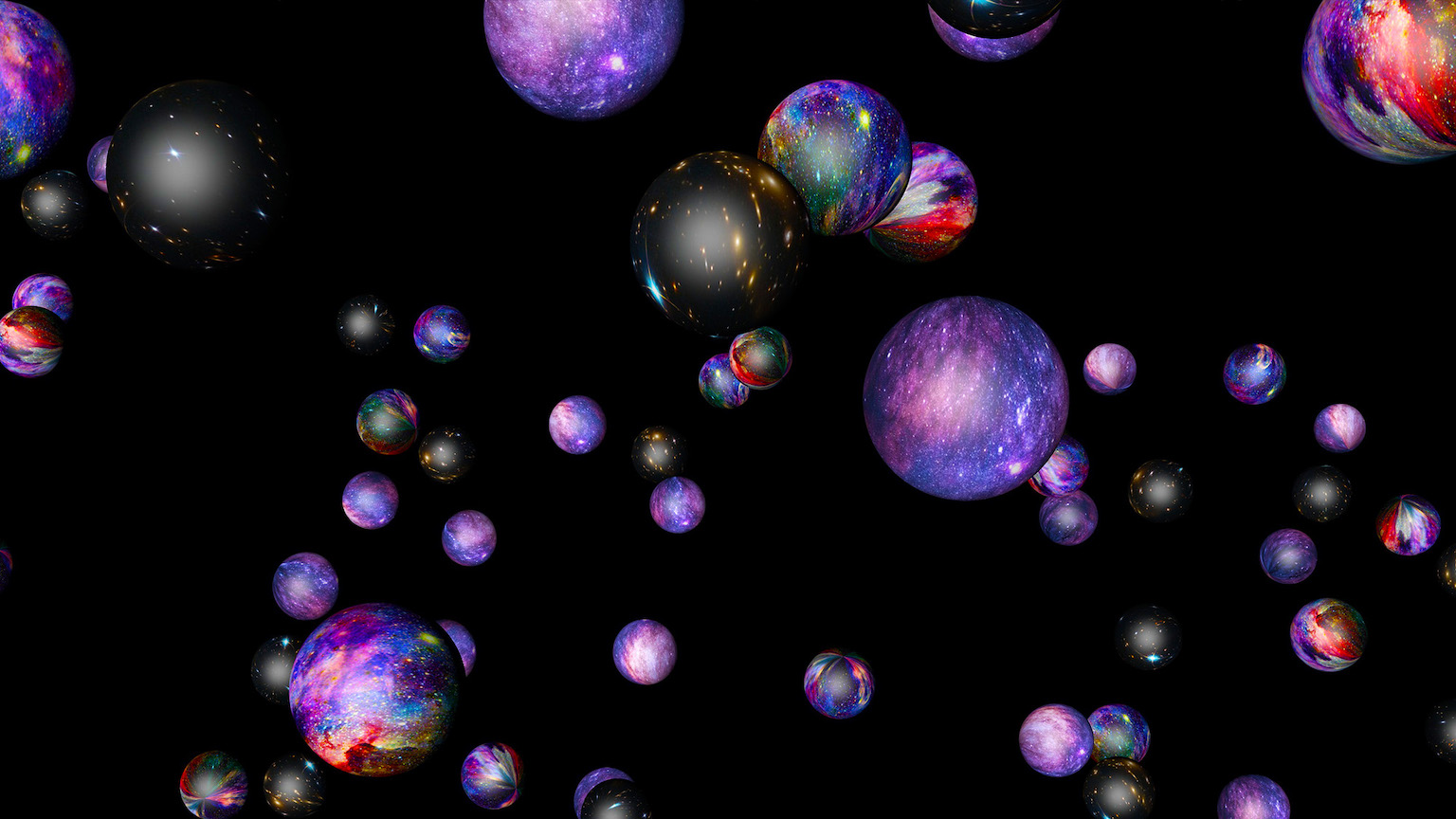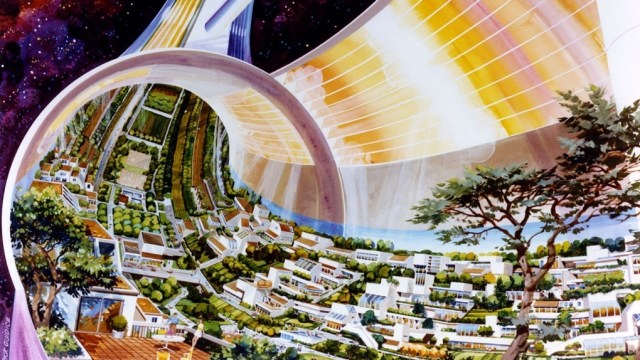Ask Ethan: Can Dark Matter Really Explain The Universe’s Structure?
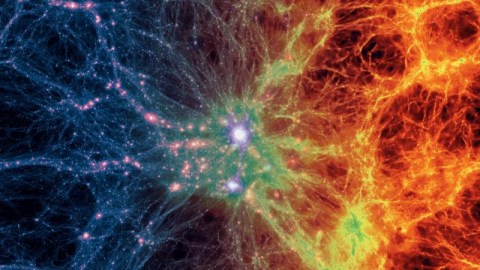
Why does dark matter, if it doesn’t dissipate energy, become gravitationally bound at all?
One of the most puzzling components of the Universe has to be dark matter. Although we have extraordinary astrophysical evidence that the normal matter in the Universe — the stuff made out of known particles in the Standard Model — cannot account for the majority of the gravitational effects we observe, all of that evidence is indirect. We still have yet to obtain a shred of repeatable, verifiable direct evidence for whatever particle might be responsible for dark matter. The total evidence places very tight constraints on any non-gravitational interactions that dark matter might possess. But if dark matter only interacts via the gravitational force, can it really explain the Universe’s structure? That’s what Patreon supporter Dr. Laird Whitehill wants to know, asking:
“If dark matter particles don’t interact and the only force that governs their motion is gravity, how do dark matter particles coalesce into a cloud? [In other words,] why aren’t all the particles hyperbolic?”
This is a very deep question, and the answer takes us deep into the heart of how gravity works in the Universe. Let’s start in our own backyard.
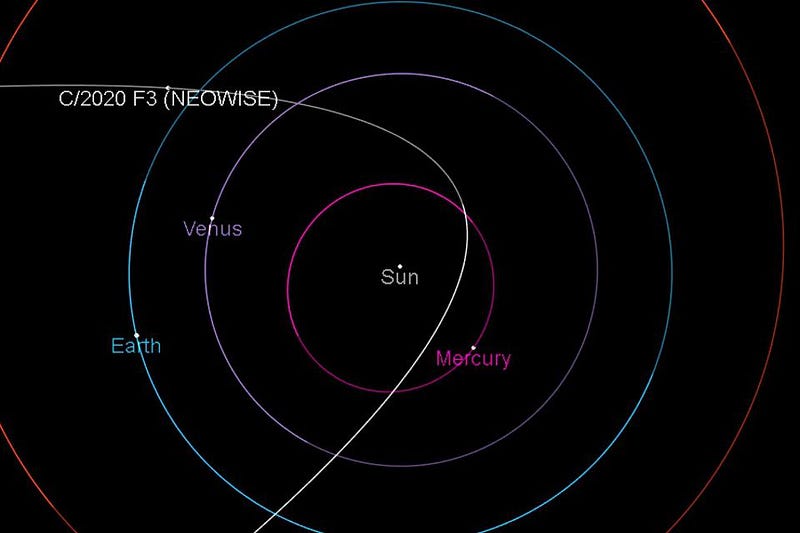
Here in our Solar System, over 99.8% of the mass exists in just one central location: our Sun. If any other mass comes close enough to be significantly influenced by the Sun’s gravitation, there are only four possible trajectories it can take on.
- It can make an elliptical orbit around the Sun, which it will always do if it’s gravitationally bound.
- It can make a circular orbit around the Sun, which is also gravitationally bound but has a special set of orbital parameters.
- It can make a parabolic orbit around the Sun, which it does if it’s right on the border of being gravitationally bound vs. being unbound.
- Or it can make a hyperbolic orbit, which is what it will always make if it’s gravitationally unbound.
Objects that come into our Solar System from outside of it — interstellar interlopers such as ‘Oumuamua or Borisov — will always make a hyperbolic orbit so long as they’re only influenced by the Sun’s (and not any of the other objects in the Solar System’s) gravitation.
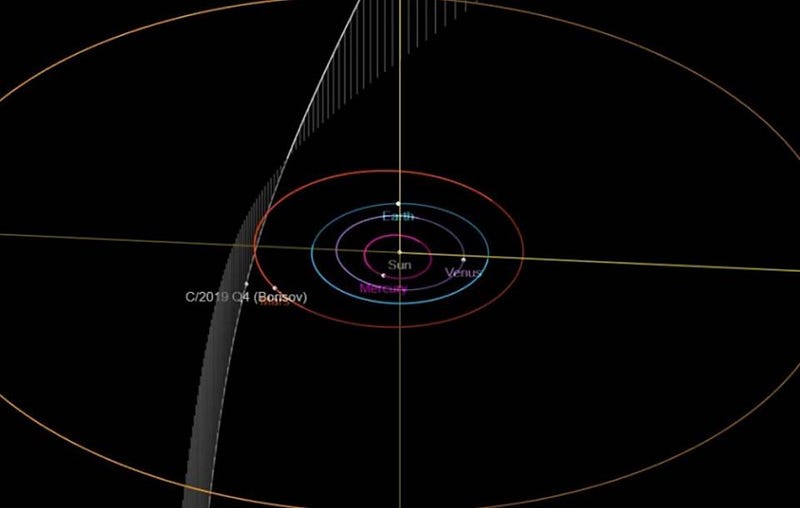
That’s because gravity is what we call a conservative force: objects that only interact gravitationally will enter a region of space with the same speed and same kinetic energy that they’ll leave it with. Gravity will only change the object’s trajectory, not its speed or its energy; both of those quantities are conserved, as neither energy nor momentum is either liberated or lost by the system.
Although we’ve observed this to be true in a great many instances — both inside and outside of our Solar System — it’s exactly theoretically true in Newtonian gravity, and would be exactly true in General Relativity if you were willing to ignore the minuscule amount of energy lost due to gravitational waves. Which means that any object that only interacts gravitationally, including a lone dark matter particle, would enter the Solar System at a particular speed, come close to the Sun and reach a maximum speed, would be redirected by gravity, and would exit the Solar System at the exact same speed (but a different direction) compared to what it entered with.
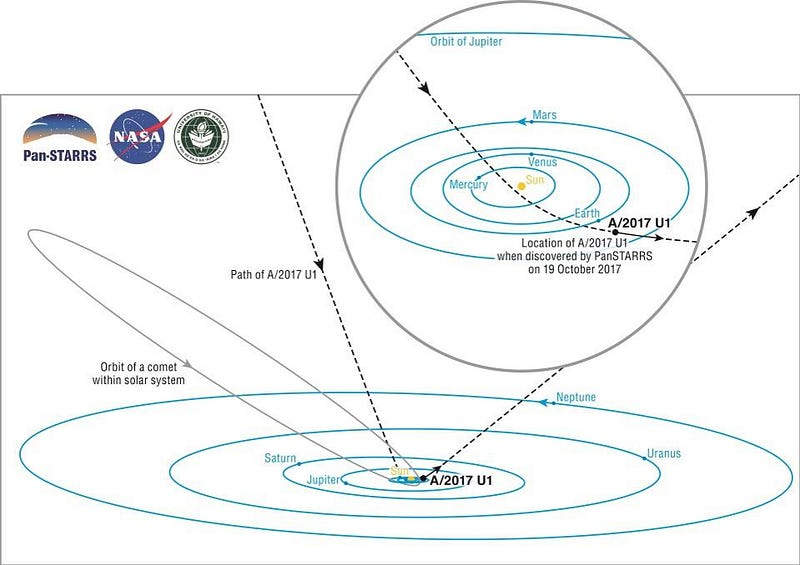
The reason that normal matter forms the complex structures that we see, structures like galaxies, star clusters, individual Solar Systems and other “clumps” of matter, is because it can experience these non-gravitational interactions. Through the electromagnetic and nuclear forces, normal matter can do all of the following:
- experience “sticky” inelastic collisions, where two or more particles bind together to form a composite particle,
- interact with radiation, where they can either radiate energy away (in the form of heat) or absorb radiation, changing its kinetic energy and its momentum,
- and can efficiently dissipate energy, enabling a type of gravitational collapse that dark matter cannot undergo.
Whereas, in an unchanging system, a dark matter particle that falls in at a certain speed would inevitably exit at the same speed (and radius) that it entered at, a particle made of normal matter could interact in a non-gravitational way with all the other particles of normal matter and radiation inside. In general, it will collide with those particles, transferring energy between them, leading to the production of radiation, and creating a more tightly bound final state than the initial state.
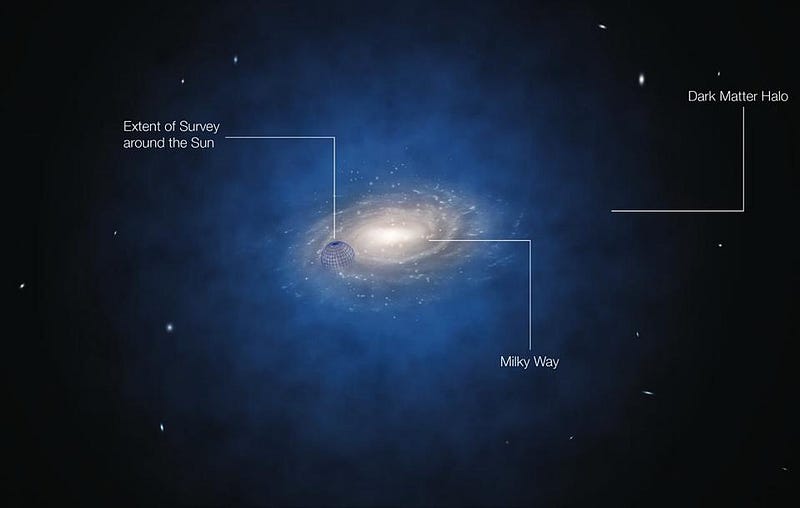
Normal matter, because it can dissipate its energy and momentum in a way that dark matter can’t, can easily form bound, collapsed structures. Dark matter, on the other hand, cannot. If you only have gravitational interactions when you fall into an established, unchanging structure, you’ll leave with the same properties you entered with.
But the Universe isn’t truly an established, unchanging place, and that changes the story dramatically. In particular, there are two phenomena that we need to pay attention to, because they both play important roles.
- The Universe is not static and unchanging, but rather expanding over time.
- The structures within the Universe aren’t static and unchanging, but rather undergo gravitational growth over time.
These two facts each, on their own, can alter the fate of a dark matter particle that comes under the influence of a massive structure that it happens to encounter.
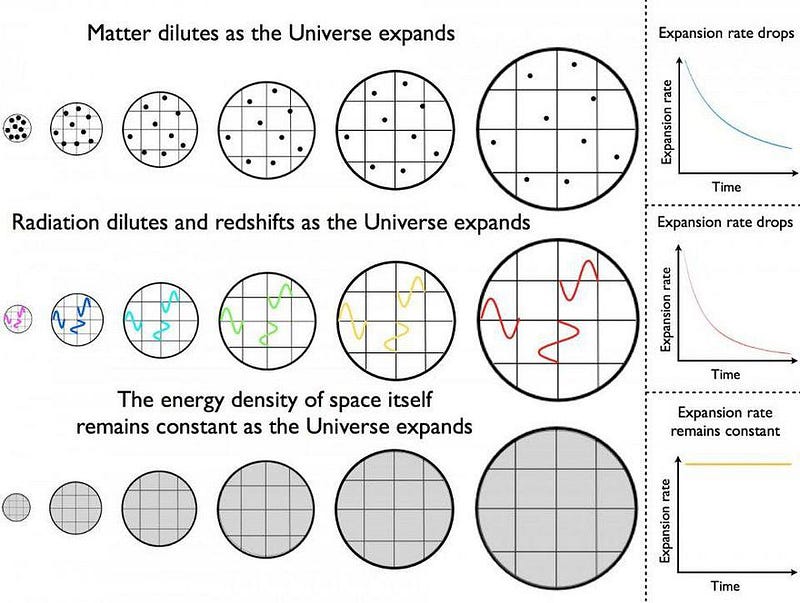
1.) The expanding Universe. The fact that the Universe is expanding does a number of important things. It reduces the number density of particles, because it increases the volume of the Universe while leaving the total mass the same. It causes the wavelength of radiation to redshift, because the distance between any two arbitrary points in the Universe — even the two points that define what a “wavelength” is for an individual photon — stretches over time, lengthening its wavelength and bringing it to progressively lower energies.
Well, massive particles, even dark matter particles, are also affected by the expanding Universe. They aren’t defined by a wavelength the way that photons are, but do have a certain kinetic energy at any given moment in time. Over time, as the Universe expands, that kinetic energy will drop, lowering their velocity relative to any nearby observer as the Universe expands.
Here’s how you can picture it.
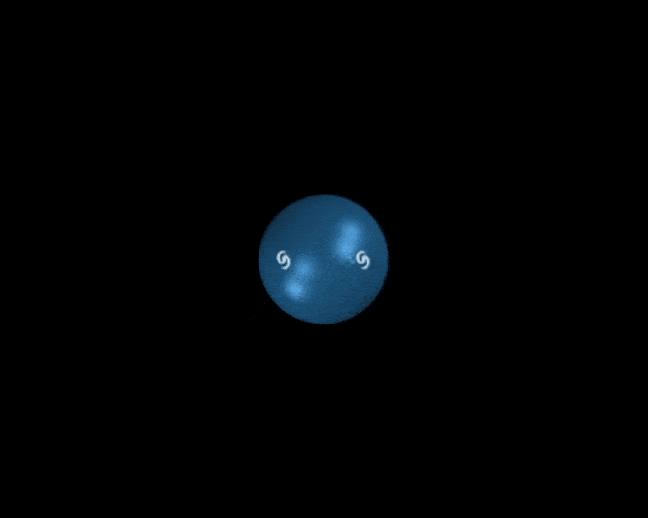
Imagine that you’ve got a particle moving through space, from point A (where it starts off) to point B (which is where it’ll wind up). If space were unchanging and not expanding, and there were no gravity, then whatever speed it started out having at point A would be the same as the arrival speed at point B.
But space is expanding. When the particle leaves point A, it has a certain speed, where speed is defined as a distance over a time. As the Universe expands, the distance between point A and point B also expands, meaning that the distance increases over time. The particle itself, over time, traverses a smaller percentage of the distance separating A from B as time goes on. Therefore, the particle moves towards B at a slower pace near the end of its journey than near the beginning of its journey.
This applies even as a dark matter particle approaches and falls into a large gravitational structure, like a galaxy or a galaxy cluster. From the time it begins to fall into a structure to the time it would reach the other side and be ready to exit back out again, the expansion of the Universe has lowered its speed, meaning that an infalling particle that was only slightly gravitationally unbound when it first encountered a structure can become slightly gravitationally bound due to the expanding Universe.
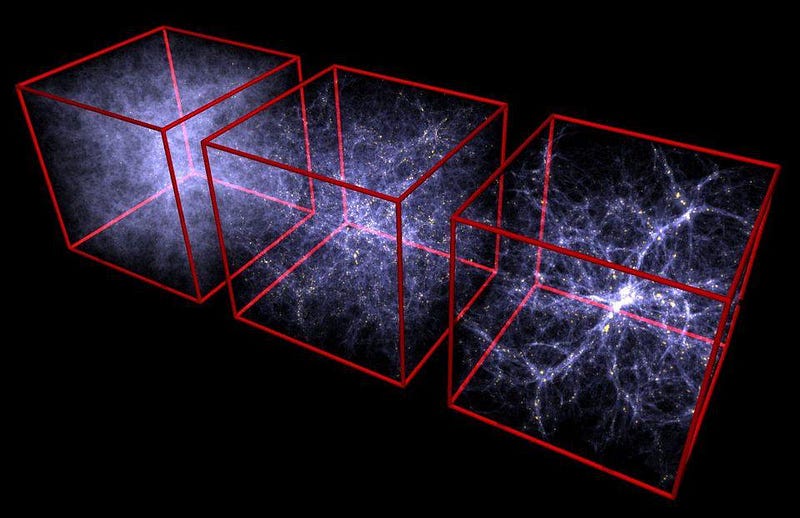
2.) Gravitational growth. This is a slightly different effect, but one that’s no less important: gravitationally bound structures grow over time, as more and more matter falls into them. Gravitation is a runaway force in the Universe in the sense that if you start with a uniform Universe, where everywhere around you has the same density except for one location that’s a slight amount denser than average, that region will progressively swallow up more and more of the surrounding matter over time. The more mass you have in one region, the greater the gravitational force gets, making it easier to attract more and more mass as time goes on.
Now, let’s imagine that you’re a dark matter particle that happens to fall into one of these gravitationally growing regions. You enter this region with a small but positive speed, drawn in by the total amount of mass inside that region. As you fall towards the center of this region, you accelerate based on the amount of mass that’s in there now. But as you fall in, other masses fall in as well — some of which are normal matter and some of which are dark matter — increasing the density and the total mass of where you are.
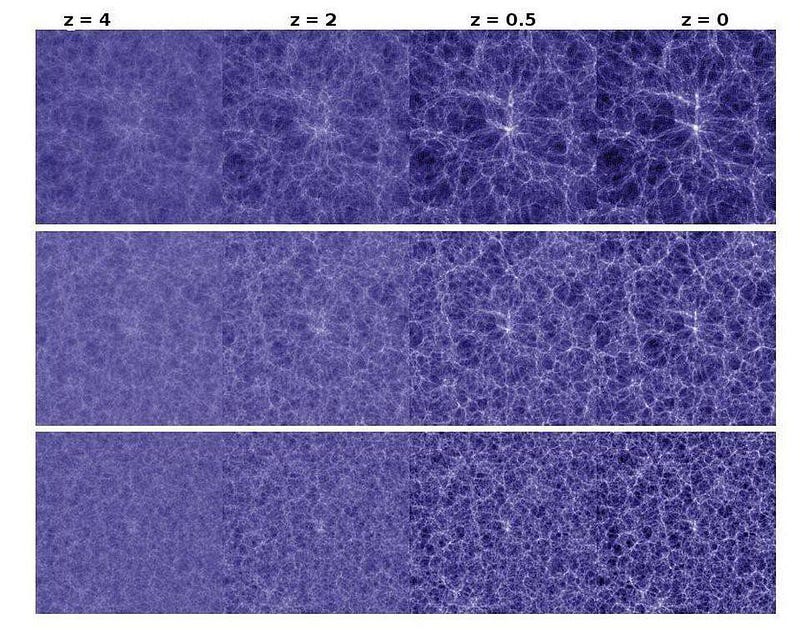
You reach the periapsis of your orbit (the closest approach to the center-of-mass of the structure you’re inside), and now you begin the long journey back out. But the amount of mass that’s now tugging back on you, that you need to overcome to get back out, has grown over time. It’s as though you fell into a solar system with the mass of our Sun, but as you go to leave, you find that you’re trying to escape from a solar system with a mass that’s a few percentage points more massive than our Sun. Which means, overall, that if you were moving slowly enough when you first fell in, you won’t be able to get back out, and you’ll remain gravitationally bound.
In reality, these two effects are both at play, and while either one can lead to dark matter becoming a part of the gravitationally bound large-scale structures in the Universe, their combined effect is even more significant. When you simulate how structure in the Universe forms with both of these effects included, you find that not only does dark matter make up the majority of the mass in these bound structures that arise, but that even if you simulated a Universe that only had dark matter — with no normal matter at all — it would still form a vast cosmic web of structure.

If the Universe were as Einstein originally envisioned it — static and unchanging with time — then dark matter particles wouldn’t become gravitationally bound at all. Any structure that a dark matter particle fell into would, a specific time later, see that dark matter particle escape once again: a situation that would apply equally to planets, solar system, galaxies, and even galaxy clusters.
But because the Universe expands, reducing the kinetic energy of particles traveling through it, and because structures also gravitationally grow over time, meaning that a particle that falls in has a tougher time getting back out again, dark matter particles wind up gravitationally bound inside these structures. Even though they don’t collide, exchange momentum, or otherwise dissipate energy, they still contribute in a meaningful way to the large-scale structure of the Universe. While only the normal matter collapses down to form ultra-dense structures like stars and planets, the dark matter remains in large, diffuse halos and filaments. When it comes to the large-scale structure of the Universe, dark matter’s presence has a clear effect that we simply can’t ignore.
Send in your Ask Ethan questions to startswithabang at gmail dot com!
Starts With A Bang is written by Ethan Siegel, Ph.D., author of Beyond The Galaxy, and Treknology: The Science of Star Trek from Tricorders to Warp Drive.
